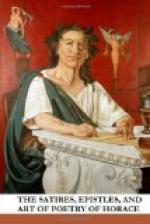Horace is scarcely less remarkable for his terseness
than for his ease: the tendency of the octosyllabic
metre in its colloquial form is to become slipshod,
interminable, in a word unclassical. Again, few
of those who use it apply it consistently to all Horace’s
hexameter poems: most make a distinction, applying
it to some and not to others. In point of fact,
however, it does not seem that any such distinction
can be made. Horace’s lightest Satires
or Epistles have generally something grave about them:
his gravest have more than one light passage.
To draw a metrical line in the English where none
is drawn in the Latin appears to me objectionable
ipso facto where it can reasonably be avoided.
That it can be avoided in the present case does not
really admit of a doubt. The English heroic couplet,
managed as Cowper has managed it, is surely quite
equal to representing all the various changes of mood
and temper which find their embodiment successively
in the Horatian hexameter. Cowper’s more
serious poems contain more of deep and sustained gravity
than is to be found in any similar production of Horace:
while on the other hand there are few things in Horace
so easy and sprightly as the Epistle to Joseph Hill,
nothing perhaps so absolutely prosaic as the Colubriad
and the verses to Mrs. Newton. There is also
an advantage in rendering the Satires of Horace in
the metre which may be called the recognized metre
of English satire, and as such has always been employed
(with one very partial and grotesque exception) by
the translators of Juvenal. Lastly, I may be
allowed to say that, while very distrustful of my
powers of managing the graver heroic, where so many
great masters have gone before me, I felt less diffidence
in attempting the lower and more colloquial form of
the measure, as not requiring the same command of
rhythm, and not exposing a writer to the same amount
of invidious comparison with his predecessors.
In what I have said I have implied that Cowper is
the right model for the English heroic as applied
to a translation of Horace: and this on the whole
I believe to be the case. Horace’s characteristics,
as I remarked just now, are ease and terseness, and
both these Cowper possesses, ease in metre, and ease
and terseness in style. Pope, on the other hand,
who in some respects would seem the better representative
of Horace, is less easy both in style and metre, while
his terseness is what Horace’s terseness is not,
trimness and antithetical smartness. Still, while
making Cowper my pattern as a general rule, I have
attempted from time to time to borrow a grace from
Pope, even, when the original gave me no warrant for
the appropriation. If Cowper’s verse could
be written by Cowper, it would probably leave nothing
to be desired in a translation of this kind:
handled by an inferior workman, it is in danger of
becoming flat, pointless, and insipid: and Horace
has many passages which, if not flat, pointless, or
insipid in themselves, are painfully liable to become




